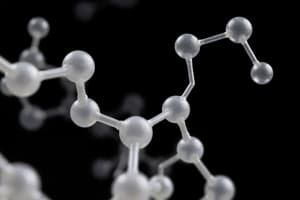Podcast
Questions and Answers
What is the simplest form of carbohydrate known as?
What is the simplest form of carbohydrate known as?
- Monosaccharides (correct)
- Oligosaccharides
- Polysaccharides
- Disaccharides
Which of the following is a defining characteristic of monosaccharides?
Which of the following is a defining characteristic of monosaccharides?
- Possess a linear structure with no carbonyl group
- Have a molecular formula of (CH2O)n (correct)
- Are always larger than three carbon atoms
- Contain only one hydroxyl group
Which of the following monosaccharides is the most abundant in nature?
Which of the following monosaccharides is the most abundant in nature?
- Glucose (correct)
- Ribose
- Fructose
- Galactose
Which structural feature differentiates the carbonyl group in monosaccharides?
Which structural feature differentiates the carbonyl group in monosaccharides?
What role do carbohydrates primarily play in biological systems?
What role do carbohydrates primarily play in biological systems?
What type of alcohol is present in the structure of monosaccharides?
What type of alcohol is present in the structure of monosaccharides?
Errors in carbohydrate processing can lead to which of the following disorders?
Errors in carbohydrate processing can lead to which of the following disorders?
How many carbon atoms does a simple monosaccharide contain at a minimum?
How many carbon atoms does a simple monosaccharide contain at a minimum?
What is the key structural difference between aldoses and ketoses?
What is the key structural difference between aldoses and ketoses?
Which of the following monosaccharides is classified as a ketopentose?
Which of the following monosaccharides is classified as a ketopentose?
In the context of monosaccharides, which statement regarding the naming of sugars is accurate?
In the context of monosaccharides, which statement regarding the naming of sugars is accurate?
What defines an aldohexose in the classification of monosaccharides?
What defines an aldohexose in the classification of monosaccharides?
Which of the following carbohydrates is NOT classified as an aldose?
Which of the following carbohydrates is NOT classified as an aldose?
Which structure represents an aldotriose?
Which structure represents an aldotriose?
What distinguishes D-sugars from L-sugars?
What distinguishes D-sugars from L-sugars?
Which of the following monosaccharides is categorized as a ketohexose?
Which of the following monosaccharides is categorized as a ketohexose?
What is a common feature of stereoisomers among monosaccharides?
What is a common feature of stereoisomers among monosaccharides?
Which carbohydrate has the molecular formula C3H6O3?
Which carbohydrate has the molecular formula C3H6O3?
Which of the following statements about monosaccharides is incorrect?
Which of the following statements about monosaccharides is incorrect?
In the classification of monosaccharides, what does the prefix 'tri-' indicate?
In the classification of monosaccharides, what does the prefix 'tri-' indicate?
Which monosaccharide is an example of an aldopentose?
Which monosaccharide is an example of an aldopentose?
What type of isomers are D-glucose and D-mannose classified as?
What type of isomers are D-glucose and D-mannose classified as?
Which carbon differs between D-galactose and D-glucose?
Which carbon differs between D-galactose and D-glucose?
Which statement about D-galactose and D-mannose is TRUE?
Which statement about D-galactose and D-mannose is TRUE?
In the Fischer projection of D-ribose, how are the hydroxyl groups oriented?
In the Fischer projection of D-ribose, how are the hydroxyl groups oriented?
Why are D-galactose and D-mannose not classified as epimers?
Why are D-galactose and D-mannose not classified as epimers?
What is the common classification suffix for monosaccharides?
What is the common classification suffix for monosaccharides?
Which of the following monosaccharides is classified as a hexose?
Which of the following monosaccharides is classified as a hexose?
What is the empirical formula for a monosaccharide?
What is the empirical formula for a monosaccharide?
Which of the following classifications describes a monosaccharide with three carbon atoms?
Which of the following classifications describes a monosaccharide with three carbon atoms?
What distinguishes aldoses from ketoses in monosaccharides?
What distinguishes aldoses from ketoses in monosaccharides?
Which monosaccharide classification includes ribose and ribulose?
Which monosaccharide classification includes ribose and ribulose?
The anomeric carbon in ketoses is typically found at which carbon position?
The anomeric carbon in ketoses is typically found at which carbon position?
What type of enzyme is hexokinase primarily associated with?
What type of enzyme is hexokinase primarily associated with?
What determines whether a monosaccharide is classified as an L-sugar or a D-sugar?
What determines whether a monosaccharide is classified as an L-sugar or a D-sugar?
Which statement is true regarding the enantiomers of monosaccharides?
Which statement is true regarding the enantiomers of monosaccharides?
What differentiates D-glucose, D-mannose, and D-galactose?
What differentiates D-glucose, D-mannose, and D-galactose?
In the Fischer projection, where is the hydroxyl group located for a D-sugar?
In the Fischer projection, where is the hydroxyl group located for a D-sugar?
Which monosaccharides are predominantly found in nature as D-isomers?
Which monosaccharides are predominantly found in nature as D-isomers?
How do L-glucose and D-glucose compare structurally?
How do L-glucose and D-glucose compare structurally?
What is true about the chiral carbon content of aldohexoses?
What is true about the chiral carbon content of aldohexoses?
What happens when only the last chiral center of D-glucose is flipped?
What happens when only the last chiral center of D-glucose is flipped?
What classification is given to a monosaccharide with five carbons?
What classification is given to a monosaccharide with five carbons?
Which monosaccharide is considered an aldose?
Which monosaccharide is considered an aldose?
How many carbon atoms are found in a hexose?
How many carbon atoms are found in a hexose?
Where is the anomeric carbon located in a ketose?
Where is the anomeric carbon located in a ketose?
What defines the classification of trioses in monosaccharides?
What defines the classification of trioses in monosaccharides?
Which of the following statements is true regarding the molecular formula of monosaccharides?
Which of the following statements is true regarding the molecular formula of monosaccharides?
What is the significance of glucose among monosaccharides in biological systems?
What is the significance of glucose among monosaccharides in biological systems?
Which functional group must at least one carbon in a monosaccharide possess?
Which functional group must at least one carbon in a monosaccharide possess?
How are the alcohol groups arranged in the structure of monosaccharides?
How are the alcohol groups arranged in the structure of monosaccharides?
Which monosaccharide is characterized by the formula C6H12O6?
Which monosaccharide is characterized by the formula C6H12O6?
Flashcards
What are carbohydrates?
What are carbohydrates?
A class of molecules consisting of hydrated carbons (carbons combined with water in a 1:1 ratio) that play many important roles in biology.
What are the biological functions of carbohydrates?
What are the biological functions of carbohydrates?
Carbohydrates are a source of energy, provide cellular structure, assist in protein folding, and are involved in cell-cell recognition and immune responses.
What are monosaccharides?
What are monosaccharides?
The simplest carbohydrates; consist of an uninterrupted carbon chain with one carbonyl carbon and other carbons as alcohols.
What criteria must a molecule meet to be classified as a monosaccharide?
What criteria must a molecule meet to be classified as a monosaccharide?
Signup and view all the flashcards
What is glucose?
What is glucose?
Signup and view all the flashcards
What are the consequences of errors in carbohydrate processing?
What are the consequences of errors in carbohydrate processing?
Signup and view all the flashcards
What is the chemical representation of an alcohol group?
What is the chemical representation of an alcohol group?
Signup and view all the flashcards
What is the chemical representation of a carbonyl group?
What is the chemical representation of a carbonyl group?
Signup and view all the flashcards
How are monosaccharides classified?
How are monosaccharides classified?
Signup and view all the flashcards
What is a triose?
What is a triose?
Signup and view all the flashcards
What is a hexose?
What is a hexose?
Signup and view all the flashcards
What is a pentose?
What is a pentose?
Signup and view all the flashcards
What is an aldose?
What is an aldose?
Signup and view all the flashcards
What is a ketose?
What is a ketose?
Signup and view all the flashcards
What is the anomeric carbon?
What is the anomeric carbon?
Signup and view all the flashcards
Give an example of each type of monosaccharide.
Give an example of each type of monosaccharide.
Signup and view all the flashcards
Aldose
Aldose
Signup and view all the flashcards
Ketose
Ketose
Signup and view all the flashcards
Anomeric Carbon
Anomeric Carbon
Signup and view all the flashcards
Aldohexose
Aldohexose
Signup and view all the flashcards
Ketopentose
Ketopentose
Signup and view all the flashcards
How do you determine if a monosaccharide is L or D?
How do you determine if a monosaccharide is L or D?
Signup and view all the flashcards
What are epimers?
What are epimers?
Signup and view all the flashcards
How to visualize L and D sugars in a Fischer projection?
How to visualize L and D sugars in a Fischer projection?
Signup and view all the flashcards
What are hexoses?
What are hexoses?
Signup and view all the flashcards
What are pentoses?
What are pentoses?
Signup and view all the flashcards
What are tetroses?
What are tetroses?
Signup and view all the flashcards
What are trioses?
What are trioses?
Signup and view all the flashcards
Which isomer is more common in nature?
Which isomer is more common in nature?
Signup and view all the flashcards
Stereoisomers
Stereoisomers
Signup and view all the flashcards
L-Sugars and D-Sugars
L-Sugars and D-Sugars
Signup and view all the flashcards
Second-to-last chiral carbon
Second-to-last chiral carbon
Signup and view all the flashcards
Different molecular formulas
Different molecular formulas
Signup and view all the flashcards
Constitutional isomers
Constitutional isomers
Signup and view all the flashcards
Stereoisomers
Stereoisomers
Signup and view all the flashcards
Anomers
Anomers
Signup and view all the flashcards
What is the difference between D-glucose and D-mannose?
What is the difference between D-glucose and D-mannose?
Signup and view all the flashcards
What is the difference between D-glucose and D-galactose?
What is the difference between D-glucose and D-galactose?
Signup and view all the flashcards
How can you remember the structure of D-ribose?
How can you remember the structure of D-ribose?
Signup and view all the flashcards
Are D-galactose and D-mannose epimers of each other?
Are D-galactose and D-mannose epimers of each other?
Signup and view all the flashcards
What are stereoisomers?
What are stereoisomers?
Signup and view all the flashcards
What are L-sugars and D-sugars?
What are L-sugars and D-sugars?
Signup and view all the flashcards
Triose
Triose
Signup and view all the flashcards
Study Notes
Introduction to Carbohydrates
- Carbohydrates are hydrated carbons (1:1 ratio of carbon to water)
- Have various roles in biology, including energy source, cellular structure, protein folding, and cell recognition.
- Errors in carbohydrate processing can lead to diseases (e.g., muscular dystrophy, Ehlers-Danlos syndrome)
Monosaccharides
- Simplest carbohydrates
- Uninterrupted carbon chain
- One carbon is a carbonyl (aldehyde or ketone)
- Other carbons are alcohols
Biologically Relevant Monosaccharides
- Contain at least 3 carbon atoms
- Have the molecular formula (CH2O)n
- Exists as a linear chain
- One carbon is an aldehyde or ketone
- Other carbons are primary/secondary alcohols
Classification by Number of Carbon Atoms
- Triose (3 carbons)
- Tetrose (4 carbons)
- Pentose (5 carbons)
- Hexose (6 carbons)
- Heptose (7 carbons)
- Octose (8 carbons)
- Nonose (9 carbons)
- Decose (10 carbons)
Important Monosaccharides
- Glucose (C6H12O6) - Most abundant in nature
- Fructose
- Mannose
- Galactose
- Ribose (C5H10O5)
- Ribulose
- Xylulose
- Glyceraldehyde
- Dihydroxyacetone (C3H6O3)
Monosaccharide Stereochemistry
- L-sugars and D-sugars
- Designated based on the chiral carbon furthest from the anomeric carbon.
- D-sugars are the predominant form found in nature.
- Important monosaccharides include D-Ribose, D-ribulose, and D-xylulose
Classification by Cyclization
- Linear form can cyclize
- Cyclized into 5- or 6-membered rings
- Furanose (5-membered ring)
- Pyranose (6-membered ring)
- Cyclization can form α or β anomers
- Anomeric carbon is the carbon that was the carbonyl group, it becomes chiral
Monosaccharide Derivatives
- Phosphosugars (e.g., glucose-6-phosphate, fructose 1,6-bisphosphate, Uridine diphosphate glucose):
- Common modification, adding a phosphate group
- Multiple phosphates may be attached (e.g., bisphosphate, trisphosphate)
- Deoxysugars (e.g., deoxyribose, a component of DNA):
- Hydroxyl group is replaced with hydrogen
- Amino Sugars (e.g., glucosamine, galactosamine, N-acetylglucosamine (GIcNAc), N-acetylgalactosamine (GalNAc), and N-acetylmannosamine (ManNAc)):
- Hydroxyl group is replaced with amino group (sometimes acetylated)
- Oxidized Sugars (e.g., glucuronic acid):
- Carbon atom oxidized to a carboxylic acid; the -ose ending is changed to -uronic acid
- Reduced Sugars (e.g., sugar alcohols):
- Aldehyde is reduced to a primary alcohol
Studying That Suits You
Use AI to generate personalized quizzes and flashcards to suit your learning preferences.
Related Documents
Description
Test your knowledge on monosaccharides with this quiz. Explore essential concepts, including their structures, types, and roles in biological systems. Perfect for students studying carbohydrate chemistry.




